Wound Management: Principles, Evaluation, Physiology, Health Education, Pain Management, and Progress Notes
VerifiedAdded on 2023/04/24
|14
|2748
|448
AI Summary
This document provides an overview of wound management, including principles, evaluation, physiology, health education, pain management, and progress notes. It also includes information on the patient's condition, wound bed status, wound measurements, wound exudate, and frequency of dressing change.
Contribute Materials
Your contribution can guide someone’s learning journey. Share your
documents today.
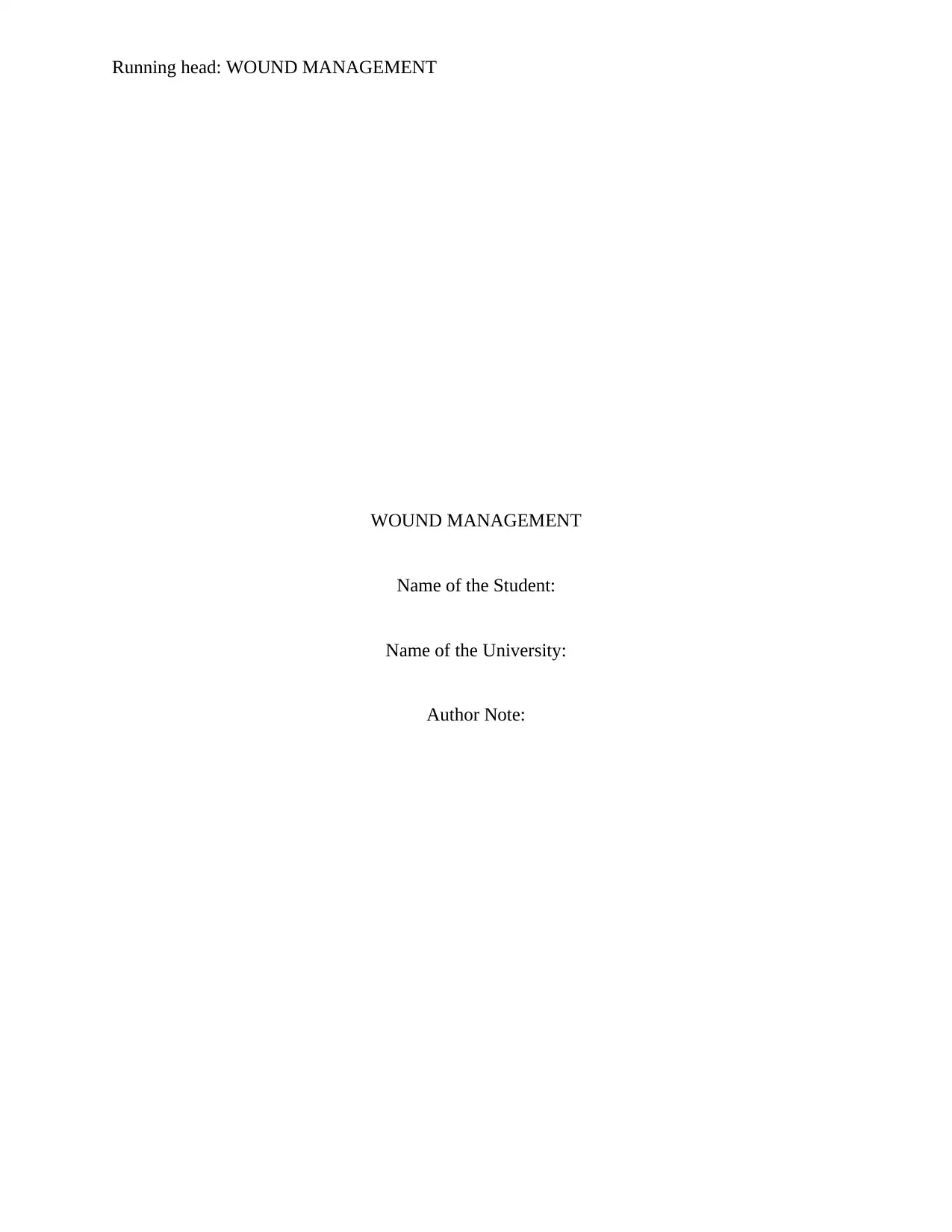
Running head: WOUND MANAGEMENT
WOUND MANAGEMENT
Name of the Student:
Name of the University:
Author Note:
WOUND MANAGEMENT
Name of the Student:
Name of the University:
Author Note:
Secure Best Marks with AI Grader
Need help grading? Try our AI Grader for instant feedback on your assignments.
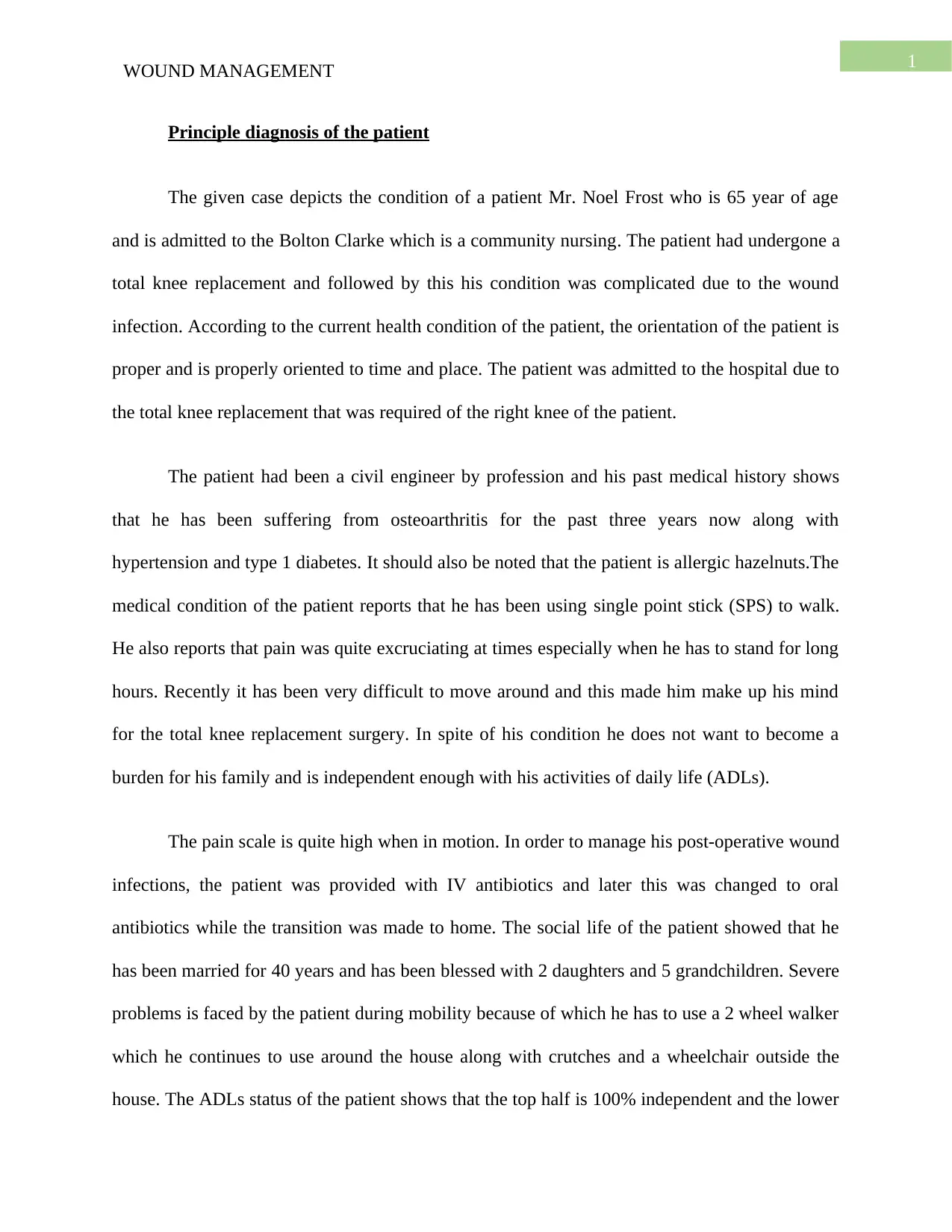
1
WOUND MANAGEMENT
Principle diagnosis of the patient
The given case depicts the condition of a patient Mr. Noel Frost who is 65 year of age
and is admitted to the Bolton Clarke which is a community nursing. The patient had undergone a
total knee replacement and followed by this his condition was complicated due to the wound
infection. According to the current health condition of the patient, the orientation of the patient is
proper and is properly oriented to time and place. The patient was admitted to the hospital due to
the total knee replacement that was required of the right knee of the patient.
The patient had been a civil engineer by profession and his past medical history shows
that he has been suffering from osteoarthritis for the past three years now along with
hypertension and type 1 diabetes. It should also be noted that the patient is allergic hazelnuts.The
medical condition of the patient reports that he has been using single point stick (SPS) to walk.
He also reports that pain was quite excruciating at times especially when he has to stand for long
hours. Recently it has been very difficult to move around and this made him make up his mind
for the total knee replacement surgery. In spite of his condition he does not want to become a
burden for his family and is independent enough with his activities of daily life (ADLs).
The pain scale is quite high when in motion. In order to manage his post-operative wound
infections, the patient was provided with IV antibiotics and later this was changed to oral
antibiotics while the transition was made to home. The social life of the patient showed that he
has been married for 40 years and has been blessed with 2 daughters and 5 grandchildren. Severe
problems is faced by the patient during mobility because of which he has to use a 2 wheel walker
which he continues to use around the house along with crutches and a wheelchair outside the
house. The ADLs status of the patient shows that the top half is 100% independent and the lower
WOUND MANAGEMENT
Principle diagnosis of the patient
The given case depicts the condition of a patient Mr. Noel Frost who is 65 year of age
and is admitted to the Bolton Clarke which is a community nursing. The patient had undergone a
total knee replacement and followed by this his condition was complicated due to the wound
infection. According to the current health condition of the patient, the orientation of the patient is
proper and is properly oriented to time and place. The patient was admitted to the hospital due to
the total knee replacement that was required of the right knee of the patient.
The patient had been a civil engineer by profession and his past medical history shows
that he has been suffering from osteoarthritis for the past three years now along with
hypertension and type 1 diabetes. It should also be noted that the patient is allergic hazelnuts.The
medical condition of the patient reports that he has been using single point stick (SPS) to walk.
He also reports that pain was quite excruciating at times especially when he has to stand for long
hours. Recently it has been very difficult to move around and this made him make up his mind
for the total knee replacement surgery. In spite of his condition he does not want to become a
burden for his family and is independent enough with his activities of daily life (ADLs).
The pain scale is quite high when in motion. In order to manage his post-operative wound
infections, the patient was provided with IV antibiotics and later this was changed to oral
antibiotics while the transition was made to home. The social life of the patient showed that he
has been married for 40 years and has been blessed with 2 daughters and 5 grandchildren. Severe
problems is faced by the patient during mobility because of which he has to use a 2 wheel walker
which he continues to use around the house along with crutches and a wheelchair outside the
house. The ADLs status of the patient shows that the top half is 100% independent and the lower
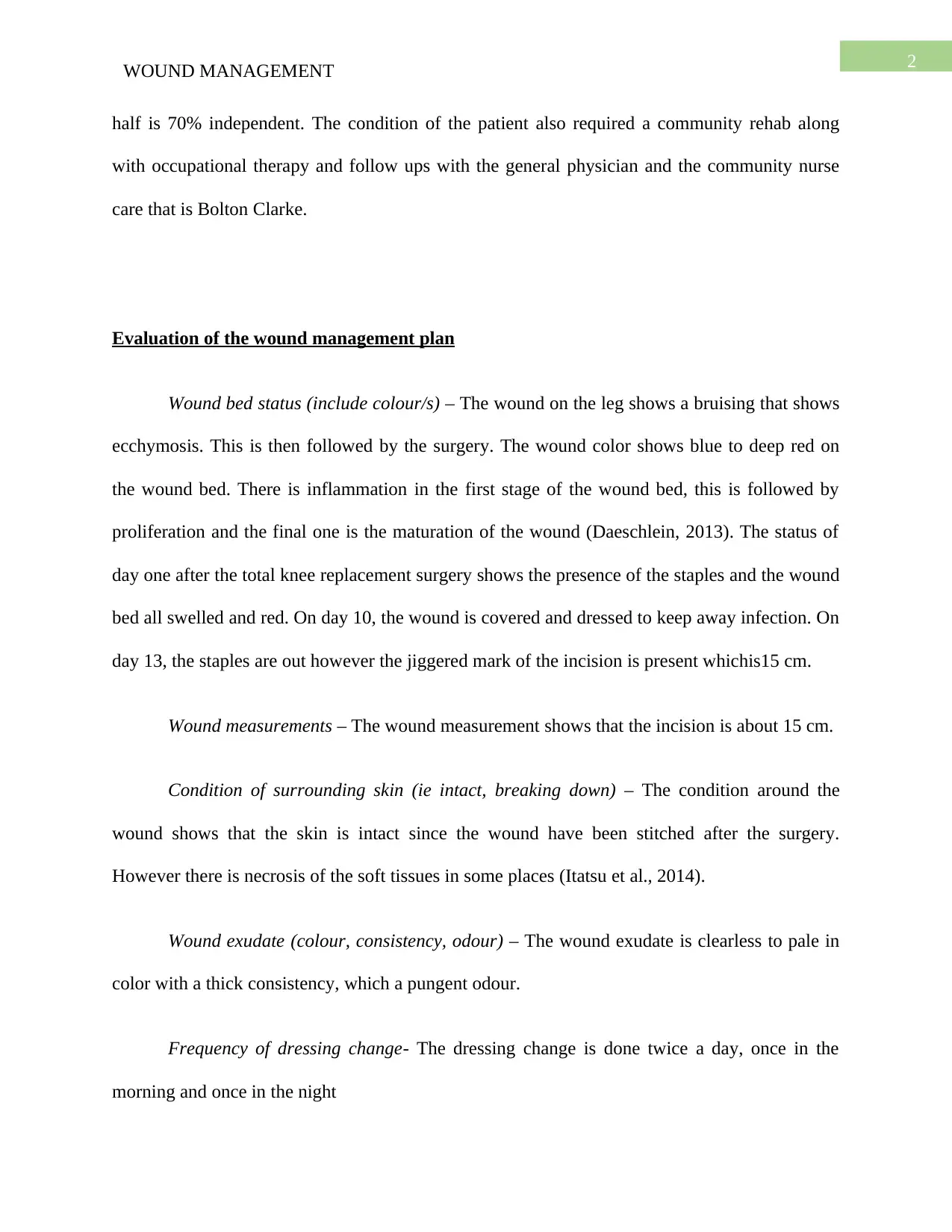
2
WOUND MANAGEMENT
half is 70% independent. The condition of the patient also required a community rehab along
with occupational therapy and follow ups with the general physician and the community nurse
care that is Bolton Clarke.
Evaluation of the wound management plan
Wound bed status (include colour/s) – The wound on the leg shows a bruising that shows
ecchymosis. This is then followed by the surgery. The wound color shows blue to deep red on
the wound bed. There is inflammation in the first stage of the wound bed, this is followed by
proliferation and the final one is the maturation of the wound (Daeschlein, 2013). The status of
day one after the total knee replacement surgery shows the presence of the staples and the wound
bed all swelled and red. On day 10, the wound is covered and dressed to keep away infection. On
day 13, the staples are out however the jiggered mark of the incision is present whichis15 cm.
Wound measurements – The wound measurement shows that the incision is about 15 cm.
Condition of surrounding skin (ie intact, breaking down) – The condition around the
wound shows that the skin is intact since the wound have been stitched after the surgery.
However there is necrosis of the soft tissues in some places (Itatsu et al., 2014).
Wound exudate (colour, consistency, odour) – The wound exudate is clearless to pale in
color with a thick consistency, which a pungent odour.
Frequency of dressing change- The dressing change is done twice a day, once in the
morning and once in the night
WOUND MANAGEMENT
half is 70% independent. The condition of the patient also required a community rehab along
with occupational therapy and follow ups with the general physician and the community nurse
care that is Bolton Clarke.
Evaluation of the wound management plan
Wound bed status (include colour/s) – The wound on the leg shows a bruising that shows
ecchymosis. This is then followed by the surgery. The wound color shows blue to deep red on
the wound bed. There is inflammation in the first stage of the wound bed, this is followed by
proliferation and the final one is the maturation of the wound (Daeschlein, 2013). The status of
day one after the total knee replacement surgery shows the presence of the staples and the wound
bed all swelled and red. On day 10, the wound is covered and dressed to keep away infection. On
day 13, the staples are out however the jiggered mark of the incision is present whichis15 cm.
Wound measurements – The wound measurement shows that the incision is about 15 cm.
Condition of surrounding skin (ie intact, breaking down) – The condition around the
wound shows that the skin is intact since the wound have been stitched after the surgery.
However there is necrosis of the soft tissues in some places (Itatsu et al., 2014).
Wound exudate (colour, consistency, odour) – The wound exudate is clearless to pale in
color with a thick consistency, which a pungent odour.
Frequency of dressing change- The dressing change is done twice a day, once in the
morning and once in the night
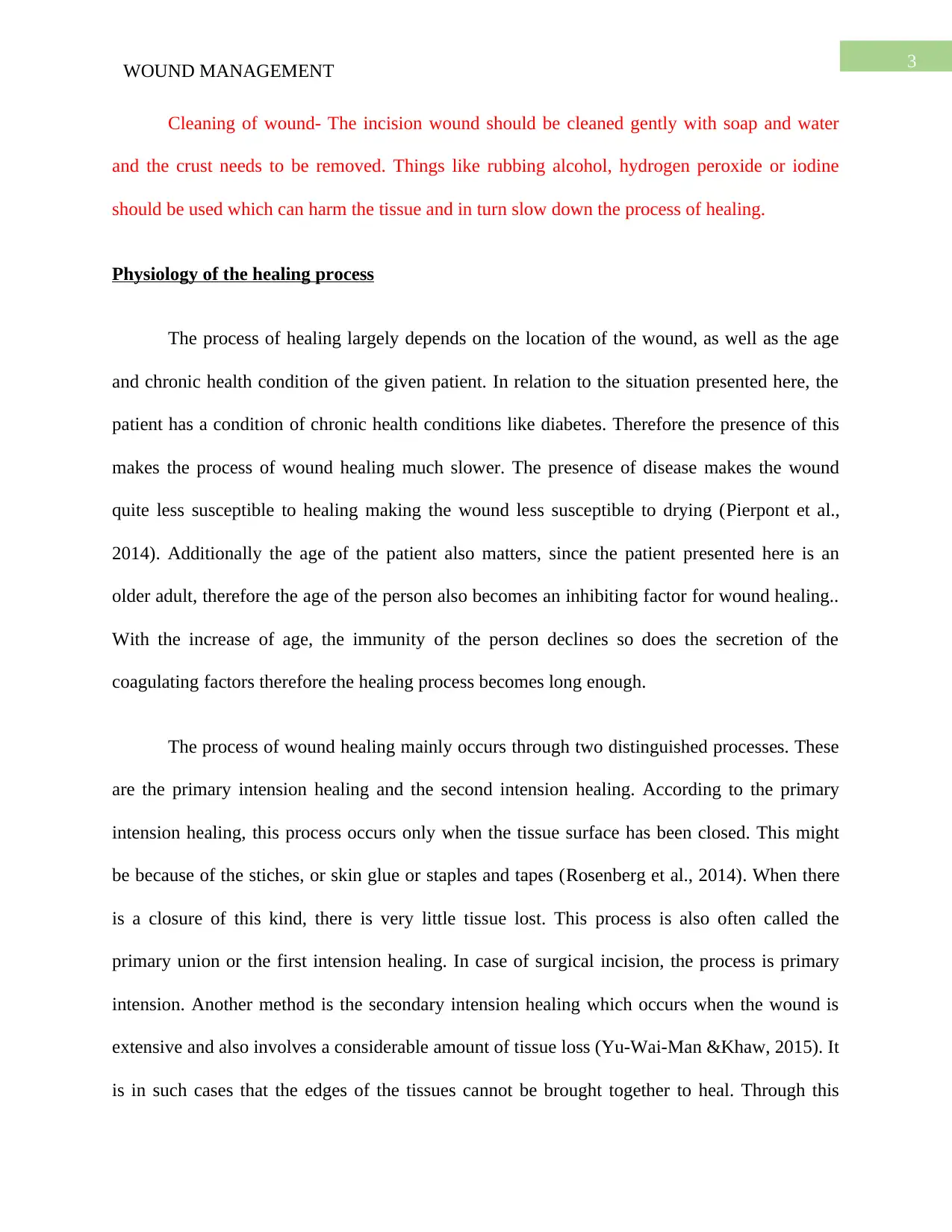
3
WOUND MANAGEMENT
Cleaning of wound- The incision wound should be cleaned gently with soap and water
and the crust needs to be removed. Things like rubbing alcohol, hydrogen peroxide or iodine
should be used which can harm the tissue and in turn slow down the process of healing.
Physiology of the healing process
The process of healing largely depends on the location of the wound, as well as the age
and chronic health condition of the given patient. In relation to the situation presented here, the
patient has a condition of chronic health conditions like diabetes. Therefore the presence of this
makes the process of wound healing much slower. The presence of disease makes the wound
quite less susceptible to healing making the wound less susceptible to drying (Pierpont et al.,
2014). Additionally the age of the patient also matters, since the patient presented here is an
older adult, therefore the age of the person also becomes an inhibiting factor for wound healing..
With the increase of age, the immunity of the person declines so does the secretion of the
coagulating factors therefore the healing process becomes long enough.
The process of wound healing mainly occurs through two distinguished processes. These
are the primary intension healing and the second intension healing. According to the primary
intension healing, this process occurs only when the tissue surface has been closed. This might
be because of the stiches, or skin glue or staples and tapes (Rosenberg et al., 2014). When there
is a closure of this kind, there is very little tissue lost. This process is also often called the
primary union or the first intension healing. In case of surgical incision, the process is primary
intension. Another method is the secondary intension healing which occurs when the wound is
extensive and also involves a considerable amount of tissue loss (Yu-Wai-Man &Khaw, 2015). It
is in such cases that the edges of the tissues cannot be brought together to heal. Through this
WOUND MANAGEMENT
Cleaning of wound- The incision wound should be cleaned gently with soap and water
and the crust needs to be removed. Things like rubbing alcohol, hydrogen peroxide or iodine
should be used which can harm the tissue and in turn slow down the process of healing.
Physiology of the healing process
The process of healing largely depends on the location of the wound, as well as the age
and chronic health condition of the given patient. In relation to the situation presented here, the
patient has a condition of chronic health conditions like diabetes. Therefore the presence of this
makes the process of wound healing much slower. The presence of disease makes the wound
quite less susceptible to healing making the wound less susceptible to drying (Pierpont et al.,
2014). Additionally the age of the patient also matters, since the patient presented here is an
older adult, therefore the age of the person also becomes an inhibiting factor for wound healing..
With the increase of age, the immunity of the person declines so does the secretion of the
coagulating factors therefore the healing process becomes long enough.
The process of wound healing mainly occurs through two distinguished processes. These
are the primary intension healing and the second intension healing. According to the primary
intension healing, this process occurs only when the tissue surface has been closed. This might
be because of the stiches, or skin glue or staples and tapes (Rosenberg et al., 2014). When there
is a closure of this kind, there is very little tissue lost. This process is also often called the
primary union or the first intension healing. In case of surgical incision, the process is primary
intension. Another method is the secondary intension healing which occurs when the wound is
extensive and also involves a considerable amount of tissue loss (Yu-Wai-Man &Khaw, 2015). It
is in such cases that the edges of the tissues cannot be brought together to heal. Through this
Secure Best Marks with AI Grader
Need help grading? Try our AI Grader for instant feedback on your assignments.
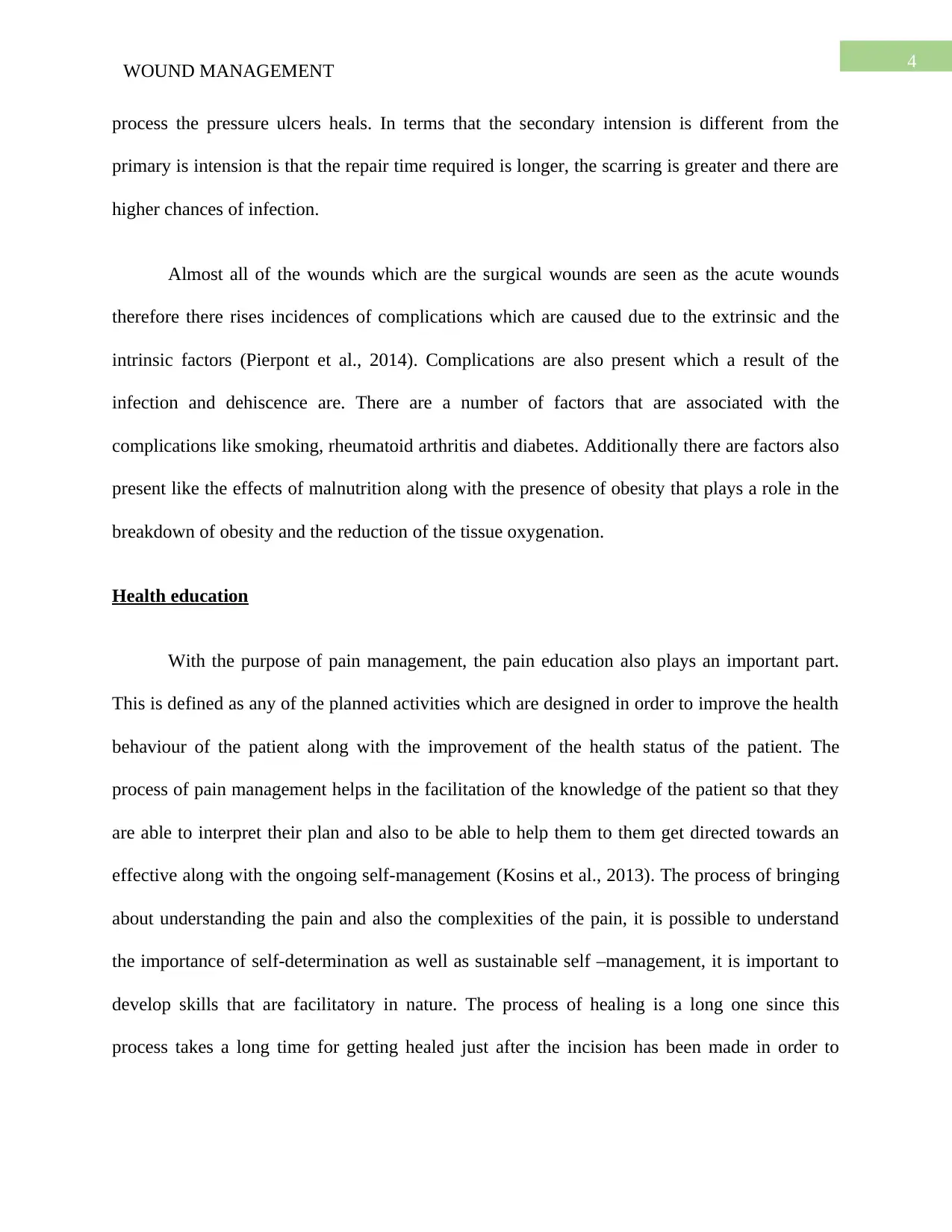
4
WOUND MANAGEMENT
process the pressure ulcers heals. In terms that the secondary intension is different from the
primary is intension is that the repair time required is longer, the scarring is greater and there are
higher chances of infection.
Almost all of the wounds which are the surgical wounds are seen as the acute wounds
therefore there rises incidences of complications which are caused due to the extrinsic and the
intrinsic factors (Pierpont et al., 2014). Complications are also present which a result of the
infection and dehiscence are. There are a number of factors that are associated with the
complications like smoking, rheumatoid arthritis and diabetes. Additionally there are factors also
present like the effects of malnutrition along with the presence of obesity that plays a role in the
breakdown of obesity and the reduction of the tissue oxygenation.
Health education
With the purpose of pain management, the pain education also plays an important part.
This is defined as any of the planned activities which are designed in order to improve the health
behaviour of the patient along with the improvement of the health status of the patient. The
process of pain management helps in the facilitation of the knowledge of the patient so that they
are able to interpret their plan and also to be able to help them to them get directed towards an
effective along with the ongoing self-management (Kosins et al., 2013). The process of bringing
about understanding the pain and also the complexities of the pain, it is possible to understand
the importance of self-determination as well as sustainable self –management, it is important to
develop skills that are facilitatory in nature. The process of healing is a long one since this
process takes a long time for getting healed just after the incision has been made in order to
WOUND MANAGEMENT
process the pressure ulcers heals. In terms that the secondary intension is different from the
primary is intension is that the repair time required is longer, the scarring is greater and there are
higher chances of infection.
Almost all of the wounds which are the surgical wounds are seen as the acute wounds
therefore there rises incidences of complications which are caused due to the extrinsic and the
intrinsic factors (Pierpont et al., 2014). Complications are also present which a result of the
infection and dehiscence are. There are a number of factors that are associated with the
complications like smoking, rheumatoid arthritis and diabetes. Additionally there are factors also
present like the effects of malnutrition along with the presence of obesity that plays a role in the
breakdown of obesity and the reduction of the tissue oxygenation.
Health education
With the purpose of pain management, the pain education also plays an important part.
This is defined as any of the planned activities which are designed in order to improve the health
behaviour of the patient along with the improvement of the health status of the patient. The
process of pain management helps in the facilitation of the knowledge of the patient so that they
are able to interpret their plan and also to be able to help them to them get directed towards an
effective along with the ongoing self-management (Kosins et al., 2013). The process of bringing
about understanding the pain and also the complexities of the pain, it is possible to understand
the importance of self-determination as well as sustainable self –management, it is important to
develop skills that are facilitatory in nature. The process of healing is a long one since this
process takes a long time for getting healed just after the incision has been made in order to
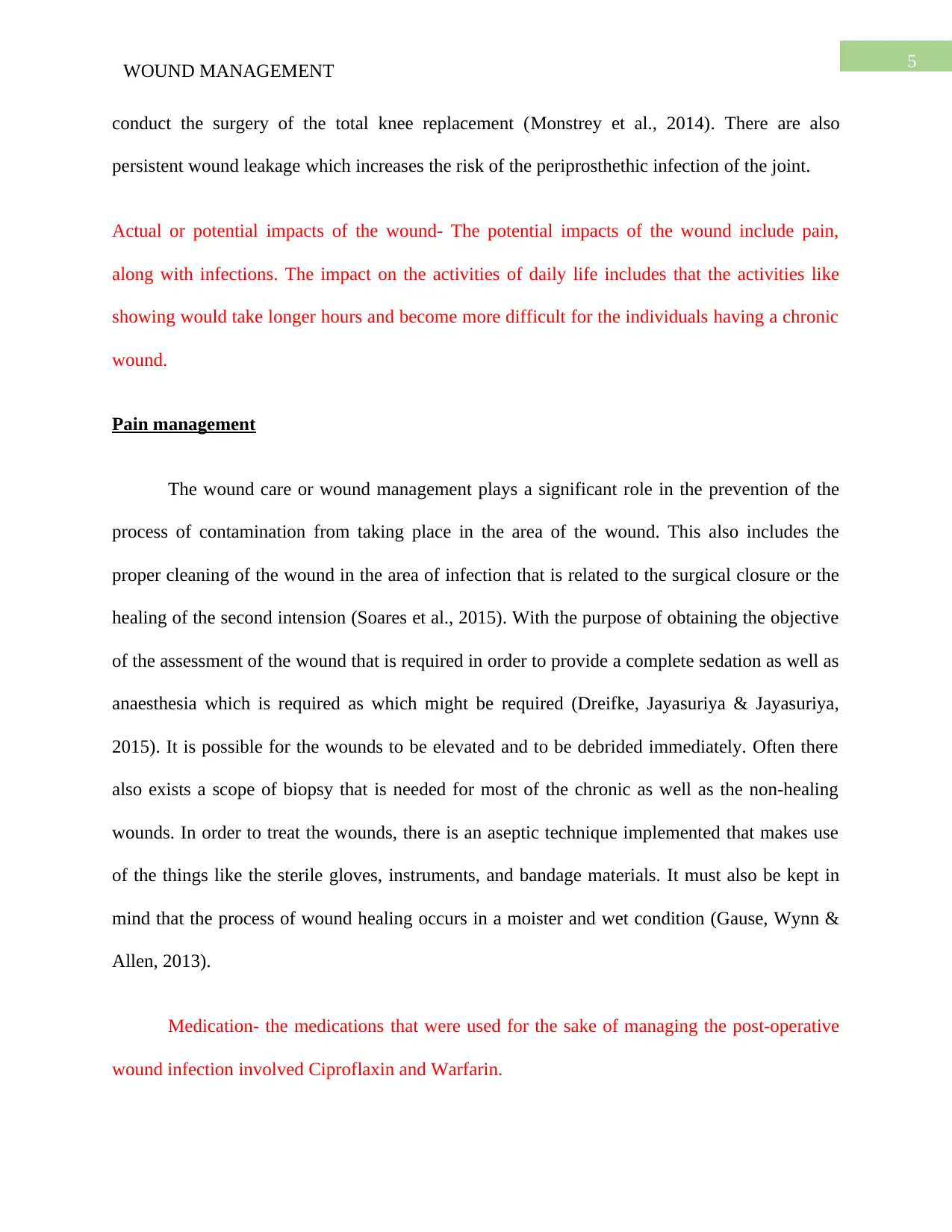
5
WOUND MANAGEMENT
conduct the surgery of the total knee replacement (Monstrey et al., 2014). There are also
persistent wound leakage which increases the risk of the periprosthethic infection of the joint.
Actual or potential impacts of the wound- The potential impacts of the wound include pain,
along with infections. The impact on the activities of daily life includes that the activities like
showing would take longer hours and become more difficult for the individuals having a chronic
wound.
Pain management
The wound care or wound management plays a significant role in the prevention of the
process of contamination from taking place in the area of the wound. This also includes the
proper cleaning of the wound in the area of infection that is related to the surgical closure or the
healing of the second intension (Soares et al., 2015). With the purpose of obtaining the objective
of the assessment of the wound that is required in order to provide a complete sedation as well as
anaesthesia which is required as which might be required (Dreifke, Jayasuriya & Jayasuriya,
2015). It is possible for the wounds to be elevated and to be debrided immediately. Often there
also exists a scope of biopsy that is needed for most of the chronic as well as the non-healing
wounds. In order to treat the wounds, there is an aseptic technique implemented that makes use
of the things like the sterile gloves, instruments, and bandage materials. It must also be kept in
mind that the process of wound healing occurs in a moister and wet condition (Gause, Wynn &
Allen, 2013).
Medication- the medications that were used for the sake of managing the post-operative
wound infection involved Ciproflaxin and Warfarin.
WOUND MANAGEMENT
conduct the surgery of the total knee replacement (Monstrey et al., 2014). There are also
persistent wound leakage which increases the risk of the periprosthethic infection of the joint.
Actual or potential impacts of the wound- The potential impacts of the wound include pain,
along with infections. The impact on the activities of daily life includes that the activities like
showing would take longer hours and become more difficult for the individuals having a chronic
wound.
Pain management
The wound care or wound management plays a significant role in the prevention of the
process of contamination from taking place in the area of the wound. This also includes the
proper cleaning of the wound in the area of infection that is related to the surgical closure or the
healing of the second intension (Soares et al., 2015). With the purpose of obtaining the objective
of the assessment of the wound that is required in order to provide a complete sedation as well as
anaesthesia which is required as which might be required (Dreifke, Jayasuriya & Jayasuriya,
2015). It is possible for the wounds to be elevated and to be debrided immediately. Often there
also exists a scope of biopsy that is needed for most of the chronic as well as the non-healing
wounds. In order to treat the wounds, there is an aseptic technique implemented that makes use
of the things like the sterile gloves, instruments, and bandage materials. It must also be kept in
mind that the process of wound healing occurs in a moister and wet condition (Gause, Wynn &
Allen, 2013).
Medication- the medications that were used for the sake of managing the post-operative
wound infection involved Ciproflaxin and Warfarin.
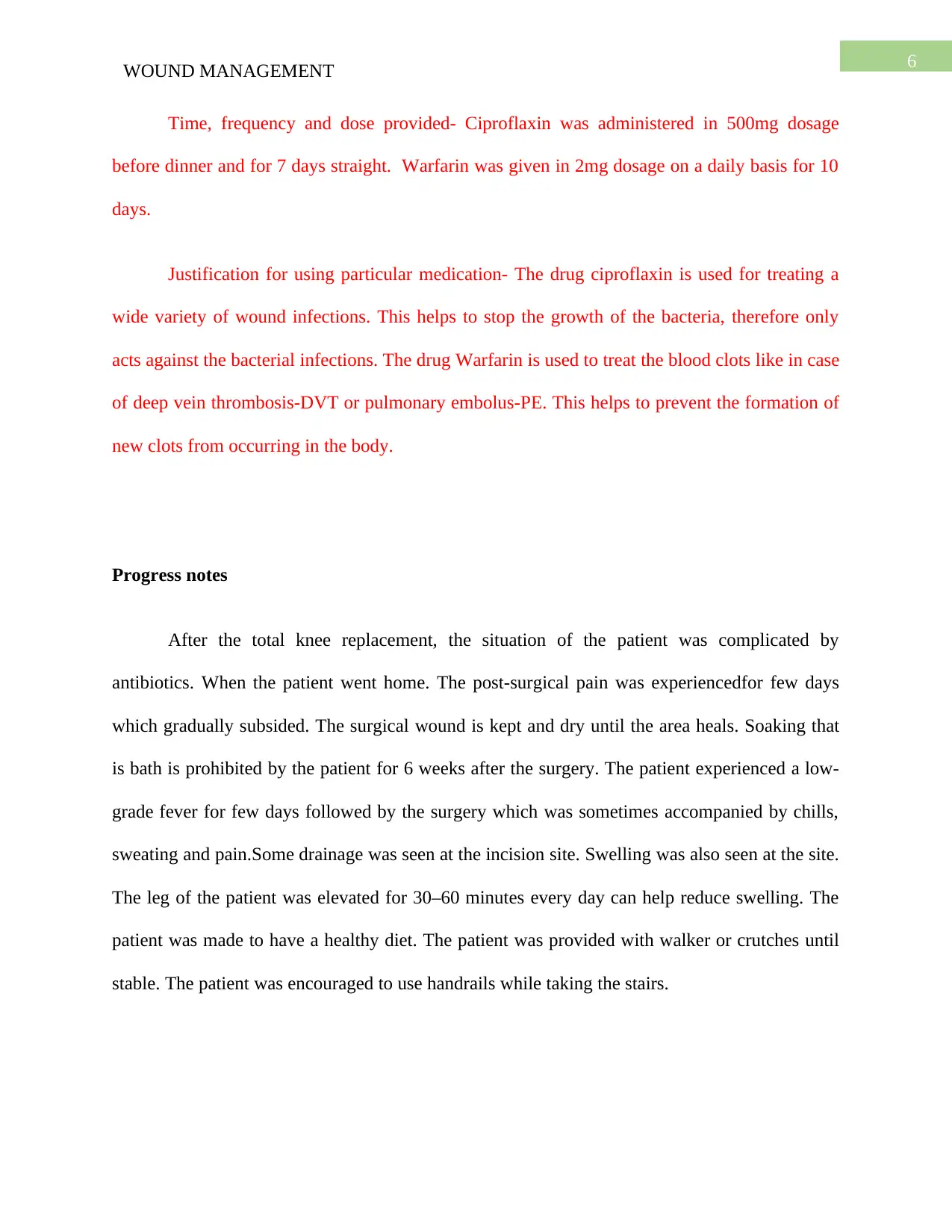
6
WOUND MANAGEMENT
Time, frequency and dose provided- Ciproflaxin was administered in 500mg dosage
before dinner and for 7 days straight. Warfarin was given in 2mg dosage on a daily basis for 10
days.
Justification for using particular medication- The drug ciproflaxin is used for treating a
wide variety of wound infections. This helps to stop the growth of the bacteria, therefore only
acts against the bacterial infections. The drug Warfarin is used to treat the blood clots like in case
of deep vein thrombosis-DVT or pulmonary embolus-PE. This helps to prevent the formation of
new clots from occurring in the body.
Progress notes
After the total knee replacement, the situation of the patient was complicated by
antibiotics. When the patient went home. The post-surgical pain was experiencedfor few days
which gradually subsided. The surgical wound is kept and dry until the area heals. Soaking that
is bath is prohibited by the patient for 6 weeks after the surgery. The patient experienced a low-
grade fever for few days followed by the surgery which was sometimes accompanied by chills,
sweating and pain.Some drainage was seen at the incision site. Swelling was also seen at the site.
The leg of the patient was elevated for 30–60 minutes every day can help reduce swelling. The
patient was made to have a healthy diet. The patient was provided with walker or crutches until
stable. The patient was encouraged to use handrails while taking the stairs.
WOUND MANAGEMENT
Time, frequency and dose provided- Ciproflaxin was administered in 500mg dosage
before dinner and for 7 days straight. Warfarin was given in 2mg dosage on a daily basis for 10
days.
Justification for using particular medication- The drug ciproflaxin is used for treating a
wide variety of wound infections. This helps to stop the growth of the bacteria, therefore only
acts against the bacterial infections. The drug Warfarin is used to treat the blood clots like in case
of deep vein thrombosis-DVT or pulmonary embolus-PE. This helps to prevent the formation of
new clots from occurring in the body.
Progress notes
After the total knee replacement, the situation of the patient was complicated by
antibiotics. When the patient went home. The post-surgical pain was experiencedfor few days
which gradually subsided. The surgical wound is kept and dry until the area heals. Soaking that
is bath is prohibited by the patient for 6 weeks after the surgery. The patient experienced a low-
grade fever for few days followed by the surgery which was sometimes accompanied by chills,
sweating and pain.Some drainage was seen at the incision site. Swelling was also seen at the site.
The leg of the patient was elevated for 30–60 minutes every day can help reduce swelling. The
patient was made to have a healthy diet. The patient was provided with walker or crutches until
stable. The patient was encouraged to use handrails while taking the stairs.
Paraphrase This Document
Need a fresh take? Get an instant paraphrase of this document with our AI Paraphraser
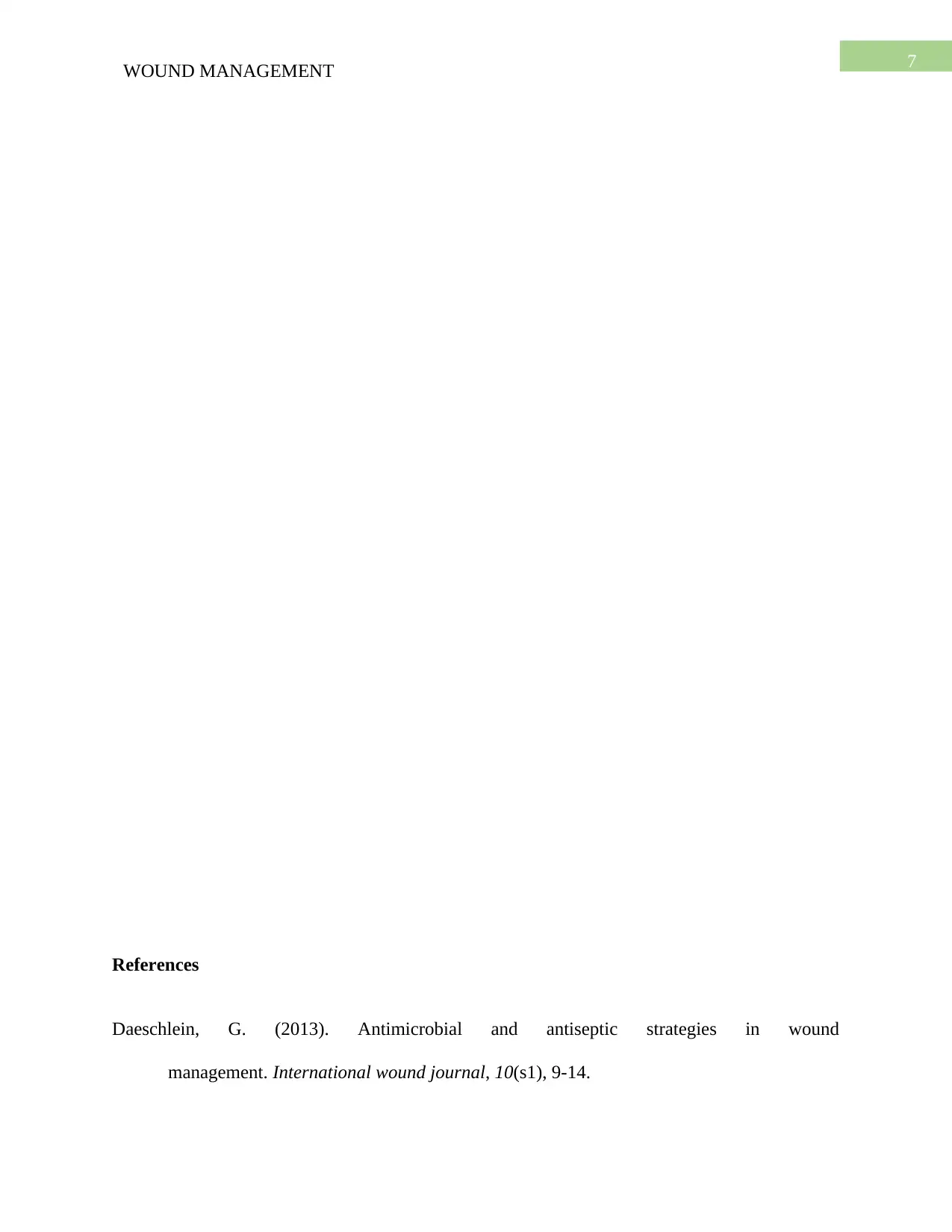
7
WOUND MANAGEMENT
References
Daeschlein, G. (2013). Antimicrobial and antiseptic strategies in wound
management. International wound journal, 10(s1), 9-14.
WOUND MANAGEMENT
References
Daeschlein, G. (2013). Antimicrobial and antiseptic strategies in wound
management. International wound journal, 10(s1), 9-14.
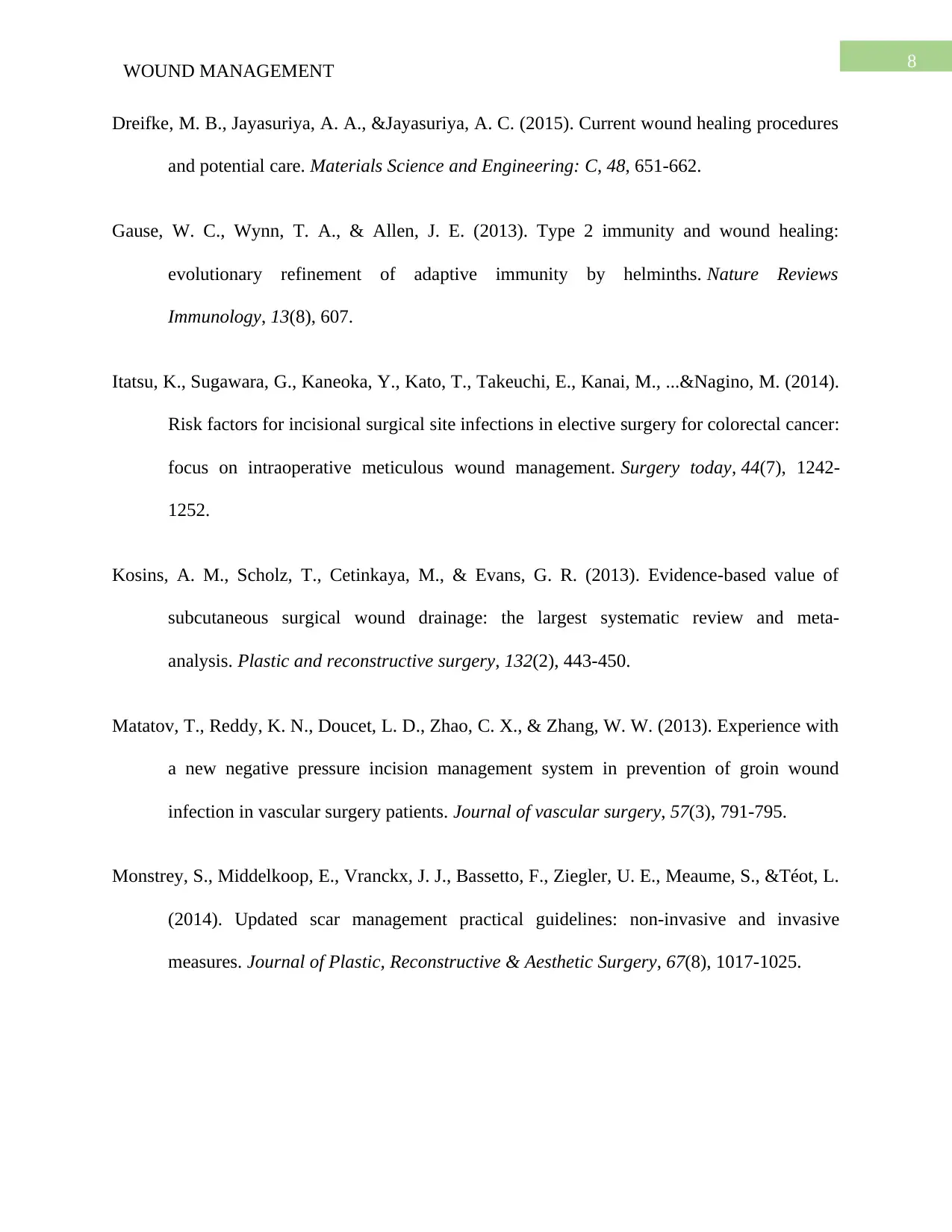
8
WOUND MANAGEMENT
Dreifke, M. B., Jayasuriya, A. A., &Jayasuriya, A. C. (2015). Current wound healing procedures
and potential care. Materials Science and Engineering: C, 48, 651-662.
Gause, W. C., Wynn, T. A., & Allen, J. E. (2013). Type 2 immunity and wound healing:
evolutionary refinement of adaptive immunity by helminths. Nature Reviews
Immunology, 13(8), 607.
Itatsu, K., Sugawara, G., Kaneoka, Y., Kato, T., Takeuchi, E., Kanai, M., ...&Nagino, M. (2014).
Risk factors for incisional surgical site infections in elective surgery for colorectal cancer:
focus on intraoperative meticulous wound management. Surgery today, 44(7), 1242-
1252.
Kosins, A. M., Scholz, T., Cetinkaya, M., & Evans, G. R. (2013). Evidence-based value of
subcutaneous surgical wound drainage: the largest systematic review and meta-
analysis. Plastic and reconstructive surgery, 132(2), 443-450.
Matatov, T., Reddy, K. N., Doucet, L. D., Zhao, C. X., & Zhang, W. W. (2013). Experience with
a new negative pressure incision management system in prevention of groin wound
infection in vascular surgery patients. Journal of vascular surgery, 57(3), 791-795.
Monstrey, S., Middelkoop, E., Vranckx, J. J., Bassetto, F., Ziegler, U. E., Meaume, S., &Téot, L.
(2014). Updated scar management practical guidelines: non-invasive and invasive
measures. Journal of Plastic, Reconstructive & Aesthetic Surgery, 67(8), 1017-1025.
WOUND MANAGEMENT
Dreifke, M. B., Jayasuriya, A. A., &Jayasuriya, A. C. (2015). Current wound healing procedures
and potential care. Materials Science and Engineering: C, 48, 651-662.
Gause, W. C., Wynn, T. A., & Allen, J. E. (2013). Type 2 immunity and wound healing:
evolutionary refinement of adaptive immunity by helminths. Nature Reviews
Immunology, 13(8), 607.
Itatsu, K., Sugawara, G., Kaneoka, Y., Kato, T., Takeuchi, E., Kanai, M., ...&Nagino, M. (2014).
Risk factors for incisional surgical site infections in elective surgery for colorectal cancer:
focus on intraoperative meticulous wound management. Surgery today, 44(7), 1242-
1252.
Kosins, A. M., Scholz, T., Cetinkaya, M., & Evans, G. R. (2013). Evidence-based value of
subcutaneous surgical wound drainage: the largest systematic review and meta-
analysis. Plastic and reconstructive surgery, 132(2), 443-450.
Matatov, T., Reddy, K. N., Doucet, L. D., Zhao, C. X., & Zhang, W. W. (2013). Experience with
a new negative pressure incision management system in prevention of groin wound
infection in vascular surgery patients. Journal of vascular surgery, 57(3), 791-795.
Monstrey, S., Middelkoop, E., Vranckx, J. J., Bassetto, F., Ziegler, U. E., Meaume, S., &Téot, L.
(2014). Updated scar management practical guidelines: non-invasive and invasive
measures. Journal of Plastic, Reconstructive & Aesthetic Surgery, 67(8), 1017-1025.
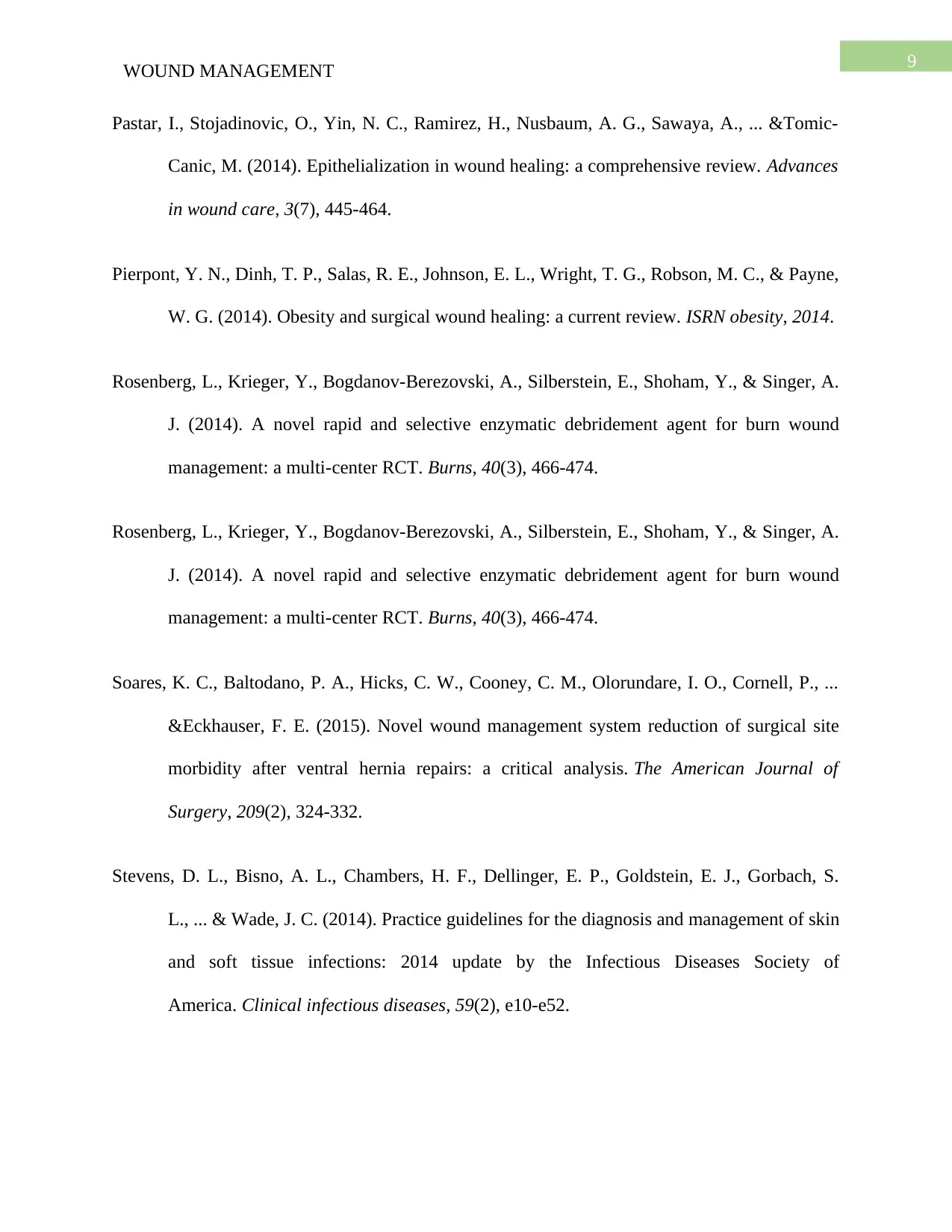
9
WOUND MANAGEMENT
Pastar, I., Stojadinovic, O., Yin, N. C., Ramirez, H., Nusbaum, A. G., Sawaya, A., ... &Tomic-
Canic, M. (2014). Epithelialization in wound healing: a comprehensive review. Advances
in wound care, 3(7), 445-464.
Pierpont, Y. N., Dinh, T. P., Salas, R. E., Johnson, E. L., Wright, T. G., Robson, M. C., & Payne,
W. G. (2014). Obesity and surgical wound healing: a current review. ISRN obesity, 2014.
Rosenberg, L., Krieger, Y., Bogdanov-Berezovski, A., Silberstein, E., Shoham, Y., & Singer, A.
J. (2014). A novel rapid and selective enzymatic debridement agent for burn wound
management: a multi-center RCT. Burns, 40(3), 466-474.
Rosenberg, L., Krieger, Y., Bogdanov-Berezovski, A., Silberstein, E., Shoham, Y., & Singer, A.
J. (2014). A novel rapid and selective enzymatic debridement agent for burn wound
management: a multi-center RCT. Burns, 40(3), 466-474.
Soares, K. C., Baltodano, P. A., Hicks, C. W., Cooney, C. M., Olorundare, I. O., Cornell, P., ...
&Eckhauser, F. E. (2015). Novel wound management system reduction of surgical site
morbidity after ventral hernia repairs: a critical analysis. The American Journal of
Surgery, 209(2), 324-332.
Stevens, D. L., Bisno, A. L., Chambers, H. F., Dellinger, E. P., Goldstein, E. J., Gorbach, S.
L., ... & Wade, J. C. (2014). Practice guidelines for the diagnosis and management of skin
and soft tissue infections: 2014 update by the Infectious Diseases Society of
America. Clinical infectious diseases, 59(2), e10-e52.
WOUND MANAGEMENT
Pastar, I., Stojadinovic, O., Yin, N. C., Ramirez, H., Nusbaum, A. G., Sawaya, A., ... &Tomic-
Canic, M. (2014). Epithelialization in wound healing: a comprehensive review. Advances
in wound care, 3(7), 445-464.
Pierpont, Y. N., Dinh, T. P., Salas, R. E., Johnson, E. L., Wright, T. G., Robson, M. C., & Payne,
W. G. (2014). Obesity and surgical wound healing: a current review. ISRN obesity, 2014.
Rosenberg, L., Krieger, Y., Bogdanov-Berezovski, A., Silberstein, E., Shoham, Y., & Singer, A.
J. (2014). A novel rapid and selective enzymatic debridement agent for burn wound
management: a multi-center RCT. Burns, 40(3), 466-474.
Rosenberg, L., Krieger, Y., Bogdanov-Berezovski, A., Silberstein, E., Shoham, Y., & Singer, A.
J. (2014). A novel rapid and selective enzymatic debridement agent for burn wound
management: a multi-center RCT. Burns, 40(3), 466-474.
Soares, K. C., Baltodano, P. A., Hicks, C. W., Cooney, C. M., Olorundare, I. O., Cornell, P., ...
&Eckhauser, F. E. (2015). Novel wound management system reduction of surgical site
morbidity after ventral hernia repairs: a critical analysis. The American Journal of
Surgery, 209(2), 324-332.
Stevens, D. L., Bisno, A. L., Chambers, H. F., Dellinger, E. P., Goldstein, E. J., Gorbach, S.
L., ... & Wade, J. C. (2014). Practice guidelines for the diagnosis and management of skin
and soft tissue infections: 2014 update by the Infectious Diseases Society of
America. Clinical infectious diseases, 59(2), e10-e52.
Secure Best Marks with AI Grader
Need help grading? Try our AI Grader for instant feedback on your assignments.
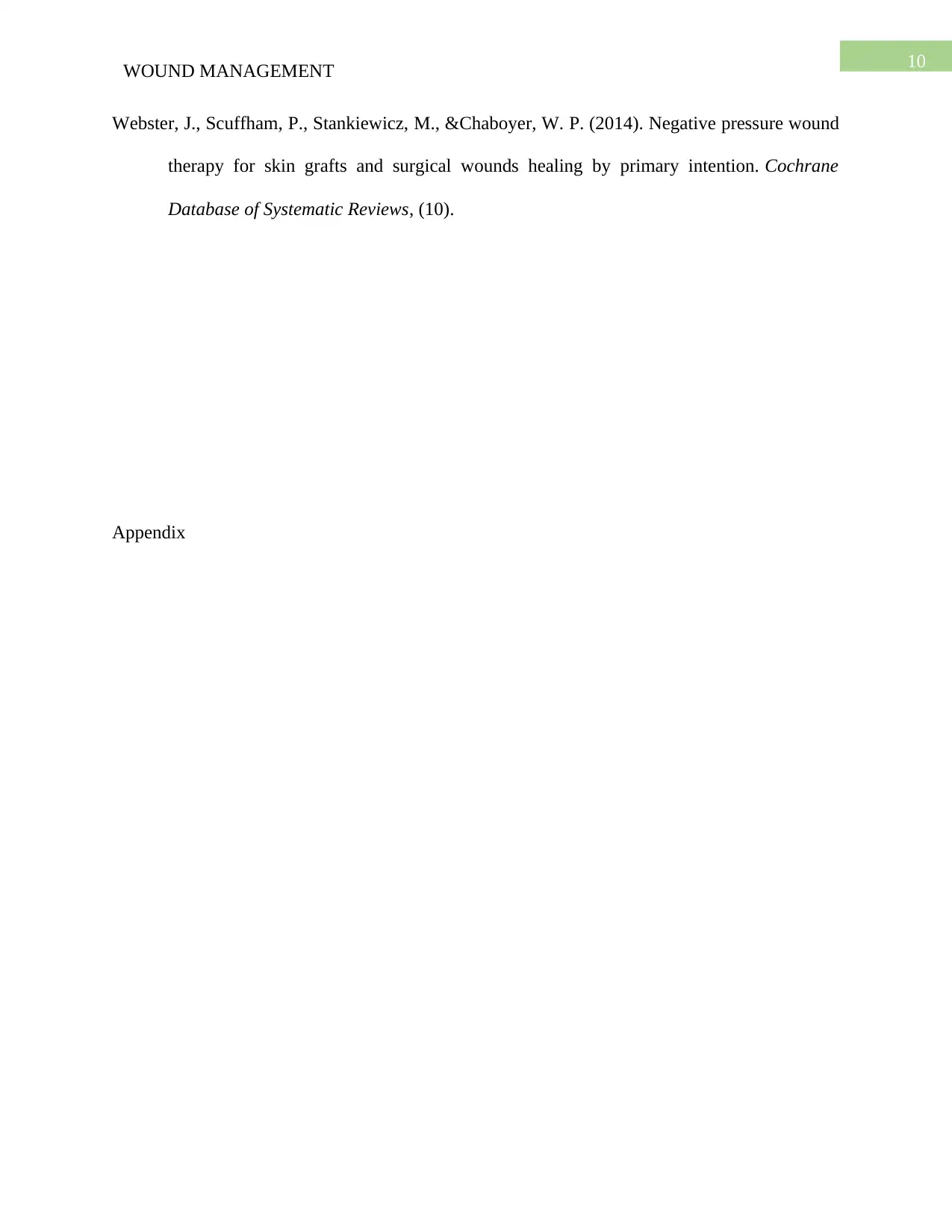
10
WOUND MANAGEMENT
Webster, J., Scuffham, P., Stankiewicz, M., &Chaboyer, W. P. (2014). Negative pressure wound
therapy for skin grafts and surgical wounds healing by primary intention. Cochrane
Database of Systematic Reviews, (10).
Appendix
WOUND MANAGEMENT
Webster, J., Scuffham, P., Stankiewicz, M., &Chaboyer, W. P. (2014). Negative pressure wound
therapy for skin grafts and surgical wounds healing by primary intention. Cochrane
Database of Systematic Reviews, (10).
Appendix
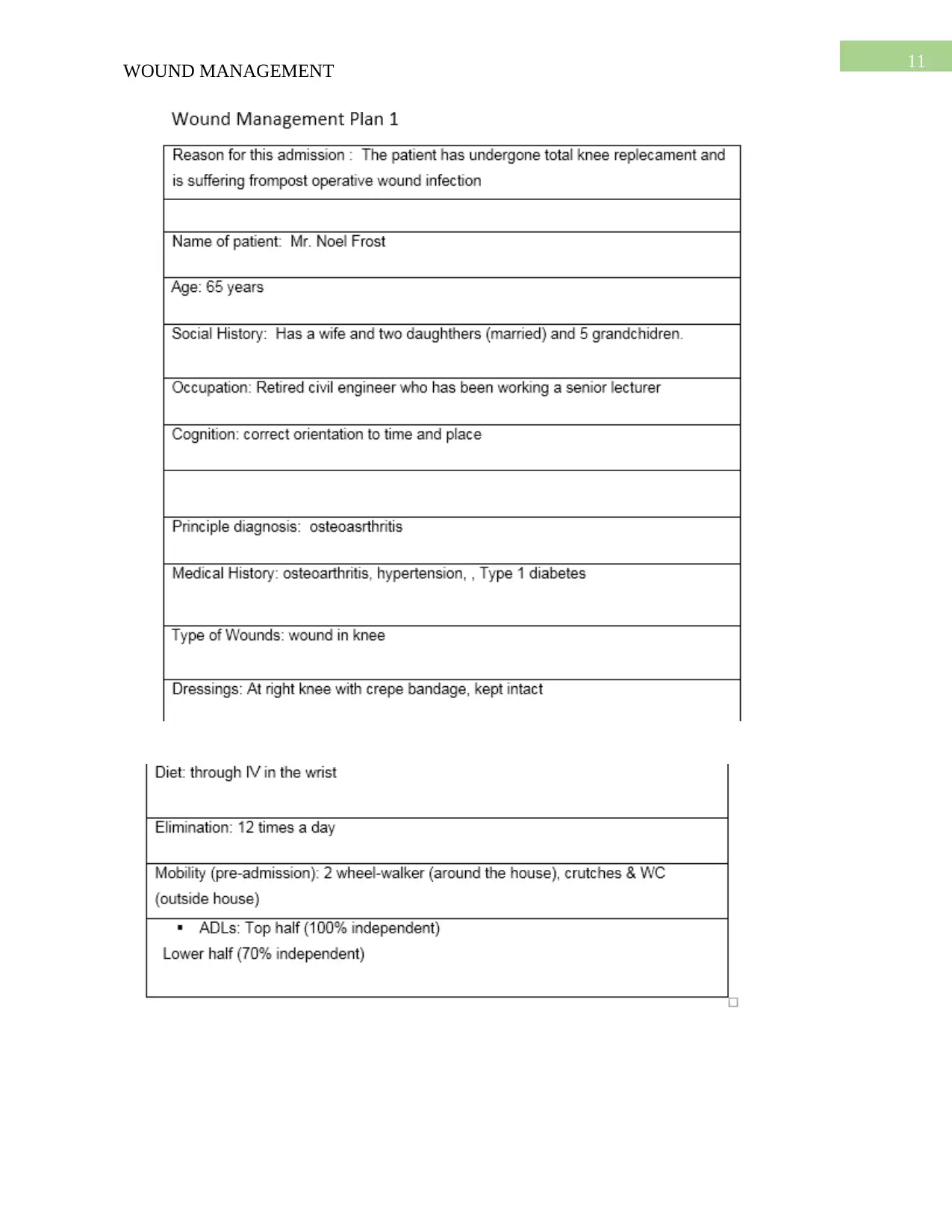
11
WOUND MANAGEMENT
WOUND MANAGEMENT
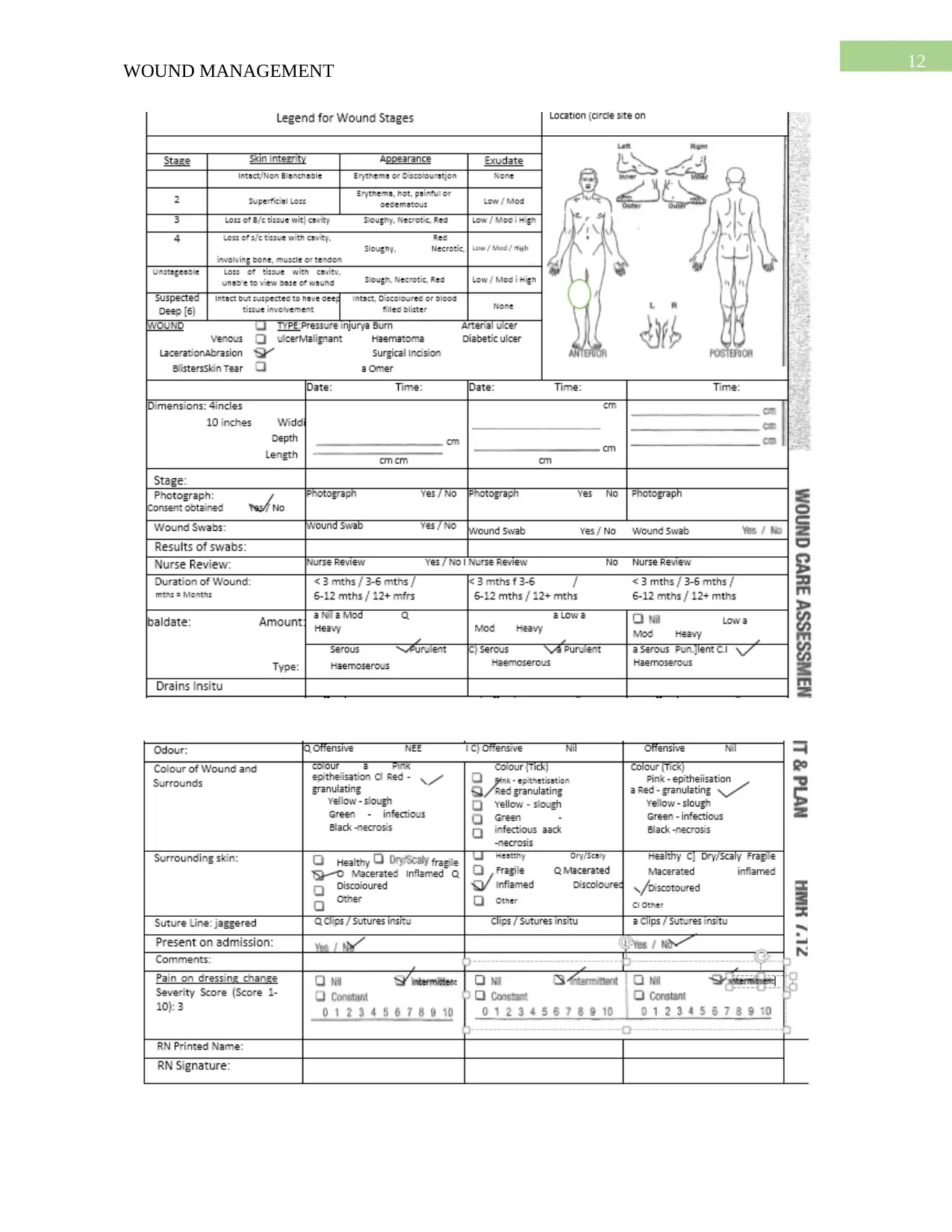
12
WOUND MANAGEMENT
WOUND MANAGEMENT
Paraphrase This Document
Need a fresh take? Get an instant paraphrase of this document with our AI Paraphraser
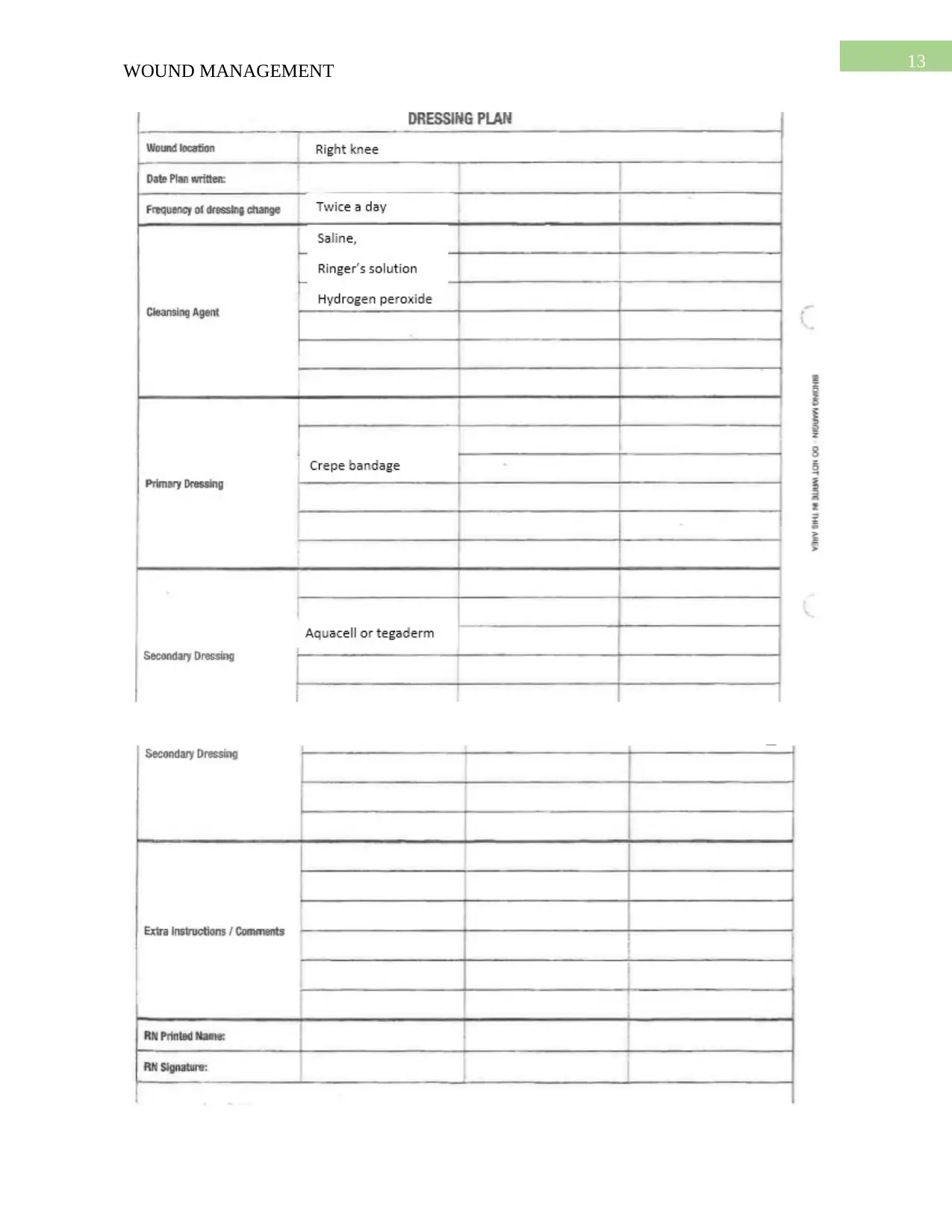
13
WOUND MANAGEMENT
WOUND MANAGEMENT
1 out of 14
Related Documents
Your All-in-One AI-Powered Toolkit for Academic Success.
+13062052269
info@desklib.com
Available 24*7 on WhatsApp / Email
![[object Object]](/_next/static/media/star-bottom.7253800d.svg)
Unlock your academic potential
© 2024 | Zucol Services PVT LTD | All rights reserved.



